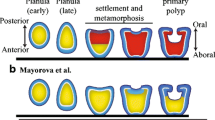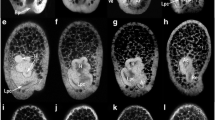Abstract
Indirect development via a feeding pluteus larva represents the ancestral mode of sea urchin development. However, some sea urchin species exhibit a derived form of development, called direct development, in which features of the feeding larva are replaced by accelerated development of the adult. A major difference between these two developmental modes is the timing of the formation of the left coelom and initiation of adult development. These processes occur much earlier in developmental and absolute time in direct developers and may be underlain by changes in morphogenetic processes. In this study, we explore whether differences in the cellular mechanisms responsible for the development of the left coelom and adult structures are associated with the change in the timing of their formation in the direct-developing sea urchin Heliocidaris erythrogramma. We present evidence that left coelom formation in H. erythrogramma, which differs in major aspects of coelom formation in indirect developers, is not a result of cell division. Further, we demonstrate that subsequent development of adult structures requires cell division.





Similar content being viewed by others
References
Angerer LM, Angerer RC (1991) Localization of mRNAs by in situ hybridization: visualization of nucleic acids. Methods Cell Biol 35:37–71
Burke RD, Myers RK, Sexton TL, Jackson C (1991) Cell movements during the initial phase of gastrulation in the sea urchin embryo. Dev Biol 146:152–557
Chapman DM (1977) Erichrome cyanin as a substitute for haematoxylin and eosin. Can J Med Technol 39:65–66
Dolbeare F, Gratzner H, Pallavicini MG, Gray JW (1983) Flow cytometric measurement of total DNA content and incorporated bromodeoxyuridine. Proc Natl Acad Sci U S A 80:5573–5577
Ettensohn CA (1984) Primary invagination of the vegetal plate during sea urchin gastrulation. Am Zool 24:571–588
Ettensohn CA (1985) Gastrulation in the sea urchin embryo is accompanied by the rearrangement of invaginating epithelial cells. Dev Biol 112:383–390
Ferkowicz MJ (1997) Wnt gene expression in sea urchins exhibiting two different forms of early development. PhD dissertation, Undiana University, Bloomington, pp 241
Ferkowicz MJ, Raff RA (2001) Wnt gene expression in sea urchin development: heterochronies associated with the evolution of developmental mode. Evol Dev 3:24–33
Haag ES (1997) Modification of gene expression during the evolution of a direct-developing sea urchin. PhD dissertation, Indiana University, Bloomington, pp 178
Hardin J (1989) Local shifts in position and polarized motility drive cell rearrangement during sea urchin gastrulation. Dev Biol 136:430–445
Hardin JD, Cheng LY (1986) The Mechanisms and mechanics of archenteron elongation during sea urchin gastrulation. Dev Biol 115:490–501
Hoegh-Guldberg O, Emlet R (1997) Energy use during the development of a lecithotrophic and a planktotrophic echinoid. Biol Bull 192:27–40
Jeffery CH, Emlet RB, Littlewood DTJ (2003) Phylogeny and evolution of developmental mode in temnopleurid echinoids. Mol Phylogenet Evol 28:99–118
Kominami T, Takata H (2004) Gastrulation in the sea urchin embryo: a model system for analyzing morphogenesis of a monolayered epithelium. Dev Growth Differ 46:309–326
McEdward L (1996) Experimental manipulation of parental investment of echinoid echinoderms. Am Zool 36:169–179
Parks AL, Parr BA, Chin J-E, Leaf DS, Raff RA (1988) Molecular analysis of heterochronic changes in the evolution of direct developing sea urchins. J Evol Biol 1:27–44
Pehrson JR, Cohen LH (1986) The fate of the small micromeres in sea urchin development. Dev Biol 113:522–526
Smith MM, Smith LC, Cameron RA, Urry LA (2008) The larval stages of the sea urchin, Stongylocentrotus purpuratus. J Morphol 269:713–733
Snoke Smith M, Zigler KS, Raff RA (2007) Evolution of direct-developing larvae: selection vs loss. Bioessays 29:566–571
Stander MC (1999) Regulation and evolution of skeletogenesis in sea urchin development. MA thesis, Indiana University, Bloomington
Stephens L, Hardin J, Keller R, Wilt F (1986) The effects of aphidicolin on morphogenesis and differentiation in the sea urchin embryo. Dev Biol 118:64–69
Strathman R (1978) The evolution and loss of feeding larval strategies of marine invertebrates. Evolution 32:894–906
Strathman RR, Fenaux L, Strathman MF (1992) Heterochronic developmental plasticity in larval sea urchins and its implications for evolution of nonfeeding larvae. Evolution 46:972–986
Tokuoka M, Setoguchi C, Kominami T (2002) Specification and differentiation processes of secondary mesenchyme-derived cells in embryos of the sea urchin Hemicentrotus pulcherrimus. Dev Growth Differ 44:239–250
Williams DHC, Anderson DT (1975) The reproductive system, embryonic development, larval development and metamorphosis of the sea urchin Heliocidaris erythrogramma (Val.) (Echinoidea: Echinometridae). Aust J Zool 23:371–403
Wray GA (1996) Parallel evolution of nonfeeding larvae in Echinoids. Syst Biol 45:308–322
Wray GA (1997) Echinoderms. In: Gilbert SF, Raunio AM (eds) Embryology, constructing the organism. Sinauer, Sunderland, pp 309–329
Wray GA, Raff RA (1991) Rapid evolution of gastrulation mechanisms in a sea urchin with lecithotrophic larvae. Evolution 45:1741–1750
Acknowledgments
This work was supported by a grant from the National Science Foundation to R.A.R., IBN-0234576 and support from an NSF predoctoral fellowship and NSF IGERT fellowship to M.S.S. We also thank the School of Biological Sciences at the University of Sydney and the Sydney aquarium for generous use of their facilities.
Author information
Authors and Affiliations
Corresponding author
Additional information
Communicated by N. Satoh
Rights and permissions
About this article
Cite this article
Smith, M.S., Collins, S. & Raff, R.A. Morphogenetic mechanisms of coelom formation in the direct-developing sea urchin Heliocidaris erythrogramma . Dev Genes Evol 219, 21–29 (2009). https://doi.org/10.1007/s00427-008-0262-8
Received:
Accepted:
Published:
Issue Date:
DOI: https://doi.org/10.1007/s00427-008-0262-8




